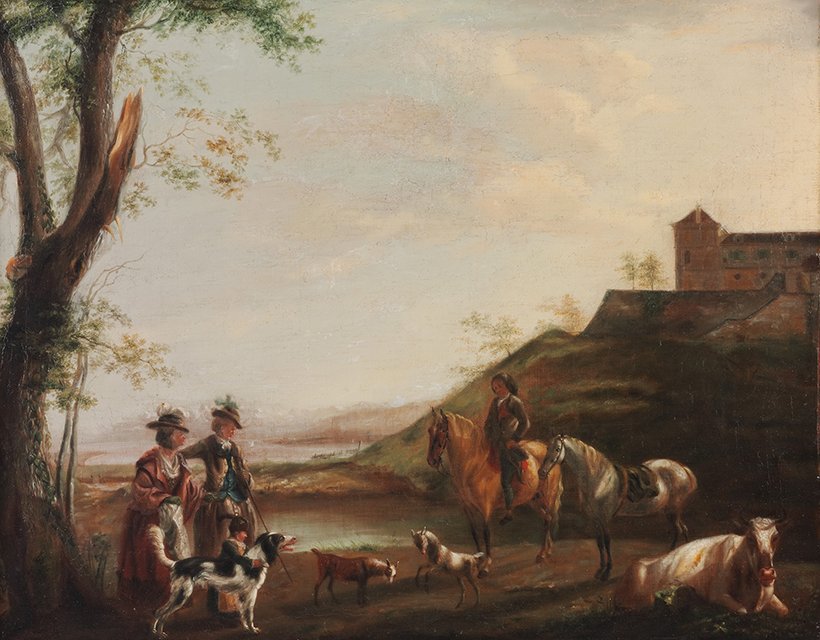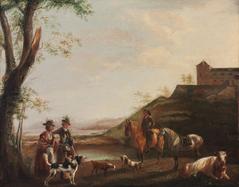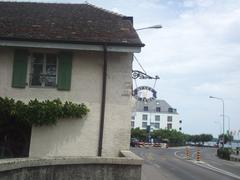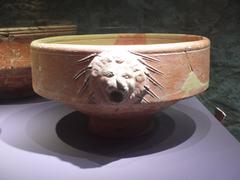
Visiting Hours, Tickets, and Historical Significance of Château de Prangins, Nyon, Switzerland
Publication Date: 19/07/2024
Introduction to Château de Prangins
Nestled in the picturesque town of Nyon, Switzerland, the Château de Prangins is a historical gem that offers a captivating glimpse into the rich tapestry of Swiss history, culture, and architecture. Originally constructed in the early 18th century by Louis Guiguer, a wealthy banker from Geneva, this château embodies the elegance of French architectural style, characterized by symmetry, classical proportions, and elaborate decorative elements (Swiss Heritage). Over the centuries, it has transitioned from a grand family residence to a refuge during World War II, and ultimately to its current role as a branch of the Swiss National Museum (Swiss National Museum). Today, Château de Prangins stands as a testament to the historical and cultural evolution of the region, offering visitors a unique blend of well-preserved Baroque architecture, engaging exhibits, and educational programs. Whether you’re a history buff, an architecture enthusiast, or a casual tourist, this guide provides an in-depth look into the history, significance, and visitor information for Château de Prangins, ensuring a memorable experience for all.
Table of Contents
- Introduction
- Early Beginnings and Construction
- The Guiguer Family Era
- Transition to the 19th Century
- The 20th Century and Restoration
- Establishment as a National Museum
- Architectural Significance
- Cultural and Educational Impact
- Visitor Information
- Special Events and Photographic Spots
- Preservation and Future Prospects
- FAQ
- Conclusion
Discover the Rich History and Visitor Guide for Château de Prangins in Nyon
Introduction
Nestled in the picturesque town of Nyon, Switzerland, the Château de Prangins is a stunning historical landmark that offers a window into the past. From its origins in the early 18th century to its present-day role as a branch of the Swiss National Museum, the château is a treasure trove of history, culture, and architectural beauty.
Early Beginnings and Construction
The Château de Prangins has a history that dates back to the early 18th century. Constructed between 1723 and 1732 by Louis Guiguer, a wealthy banker from Geneva, the château’s design was influenced by the French architectural style of the period, characterized by its symmetry, classical proportions, and elaborate decorative elements. The construction of the château marked a significant development in the region, reflecting the wealth and social status of its owner (Swiss Heritage).
The Guiguer Family Era
The Guiguer family played a crucial role in the history of Château de Prangins, with Louis Guiguer’s descendants residing in the château for several generations. The family was known for their contributions to the local community and their involvement in the political and economic affairs of the region. The château served as a residence and a center for social gatherings and cultural events (Nyon Tourism).
Transition to the 19th Century
In the 19th century, the château underwent significant changes. In 1814, it was sold to Joseph Bonaparte, the elder brother of Napoleon Bonaparte, who had been the King of Spain and Naples. Joseph Bonaparte’s ownership of the château added a layer of historical significance, linking it to the broader European political landscape of the time. However, his tenure at the château was relatively short-lived, and the property changed hands several times throughout the century (Historical Archives).
The 20th Century and Restoration
The 20th century brought new challenges and transformations for Château de Prangins. During World War II, the château was used as a refuge for displaced persons and later served various administrative purposes. By the mid-20th century, the château had fallen into a state of disrepair, prompting efforts to restore and preserve its historical and architectural integrity. In 1975, the Swiss Confederation acquired the château, recognizing its cultural and historical value (Swiss Confederation).
Establishment as a National Museum
In 1998, after extensive restoration work, Château de Prangins was inaugurated as a branch of the Swiss National Museum. This transformation marked a new chapter in the château’s history, positioning it as a key cultural and educational institution. The museum’s exhibitions focus on Swiss history from the 18th to the 20th centuries, offering visitors a comprehensive understanding of the country’s social, political, and cultural evolution. The château’s historical rooms, gardens, and collections provide a unique glimpse into the past (Swiss National Museum).
Architectural Significance
The architectural significance of Château de Prangins lies in its well-preserved Baroque style. The château’s design reflects the aesthetic principles of the early 18th century, with its grand façade, symmetrical layout, and ornate interior decorations. The restoration efforts have ensured that these architectural features remain intact, allowing visitors to appreciate the craftsmanship and artistic vision of the period. The château’s gardens, designed in the French formal style, further enhance its historical and aesthetic appeal (Architectural Digest).
Cultural and Educational Impact
Today, Château de Prangins serves as a vital cultural and educational resource. The museum’s exhibitions and programs aim to engage diverse audiences, from school groups to international tourists. The château hosts a variety of events, including lectures, workshops, and cultural festivals, fostering a deeper appreciation for Swiss history and heritage. The museum’s educational initiatives are designed to promote lifelong learning and encourage visitors to explore the rich tapestry of Switzerland’s past (Cultural Events).
Visitor Information
- Visiting Hours - The château is open from Tuesday to Sunday, 10:00 AM to 5:00 PM. It is closed on Mondays and public holidays.
- Tickets - General admission tickets cost CHF 10 for adults, CHF 8 for seniors and students, and free for children under 16. Special discounts are available for groups and families. Tickets can be purchased online or at the entrance.
- Accessibility - The château is wheelchair accessible, with elevators and ramps available for visitors with mobility issues.
- Guided Tours - Guided tours are available in several languages and can be booked in advance. These tours offer in-depth insights into the history and architecture of the château.
- Nearby Attractions - Visitors can explore other historical sites in Nyon, such as the Nyon Castle and the Roman Museum. The beautiful Lake Geneva is also nearby, offering scenic views and recreational activities.
- Travel Tips - The château is easily accessible by public transportation. Take a train to Nyon and then a short bus ride to Prangins. Parking is available for those traveling by car.
Special Events and Photographic Spots
The château hosts a variety of special events throughout the year, including historical reenactments, art exhibitions, and cultural festivals. These events provide unique opportunities to experience the château in different contexts. Photographers will find numerous picturesque spots within the château grounds, such as the formal gardens, the grand staircase, and the beautifully decorated rooms.
Preservation and Future Prospects
The preservation of Château de Prangins is an ongoing effort, supported by both public and private entities. The Swiss National Museum continues to invest in the maintenance and enhancement of the château, ensuring that it remains a vibrant and accessible cultural landmark. Future prospects for the château include expanding its exhibitions, enhancing visitor services, and developing new educational programs. These initiatives aim to sustain the château’s relevance and appeal for future generations (Preservation Society).
FAQ
Q - What are the visiting hours for Château de Prangins? A - The château is open from Tuesday to Sunday, 10:00 AM to 5:00 PM. It is closed on Mondays and public holidays.
Q - How much do tickets cost? A - General admission tickets cost CHF 10 for adults, CHF 8 for seniors and students, and free for children under 16.
Q - Is the château wheelchair accessible? A - Yes, the château is wheelchair accessible with elevators and ramps available.
Q - Are guided tours available? A - Yes, guided tours are available in several languages and can be booked in advance.
Q - What other attractions are nearby? A - Nearby attractions include Nyon Castle, the Roman Museum, and Lake Geneva.
Conclusion
The history of Château de Prangins is a testament to its enduring significance as a cultural and historical landmark. From its origins as a grand residence for the Guiguer family to its current role as a national museum, the château has witnessed and contributed to the evolving narrative of the region. Its architectural beauty, historical importance, and cultural impact make it a must-visit destination for anyone interested in exploring the rich heritage of Switzerland. Plan your visit today and immerse yourself in the captivating history and charm of Château de Prangins.
Summary and Key Takeaways
Château de Prangins is not just a historical monument; it is a living testament to the rich cultural and architectural heritage of Switzerland. From its origins as the grand residence of the Guiguer family to its current status as a key branch of the Swiss National Museum, the château has played a significant role in reflecting and preserving Swiss history and culture. Its well-preserved Baroque architecture, meticulously curated exhibits, and engaging educational programs make it a must-visit destination for anyone interested in exploring the depth of Swiss heritage (Swiss Heritage) (Swiss National Museum). The ongoing preservation efforts and future prospects for expanding its exhibitions and educational initiatives ensure that Château de Prangins will continue to be a vibrant and accessible cultural landmark for generations to come (Preservation Society). As you plan your visit, take advantage of the guided tours, special events, and nearby attractions to fully immerse yourself in the captivating history and charm of Château de Prangins.
References
- Swiss Heritage. https://www.swissheritage.ch
- Swiss National Museum. https://www.nationalmuseum.ch
- Swiss Confederation. https://www.admin.ch
- Preservation Society. https://www.preservationsociety.ch


